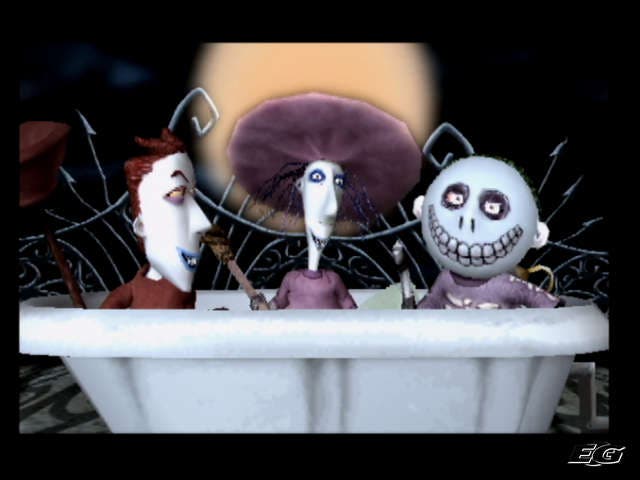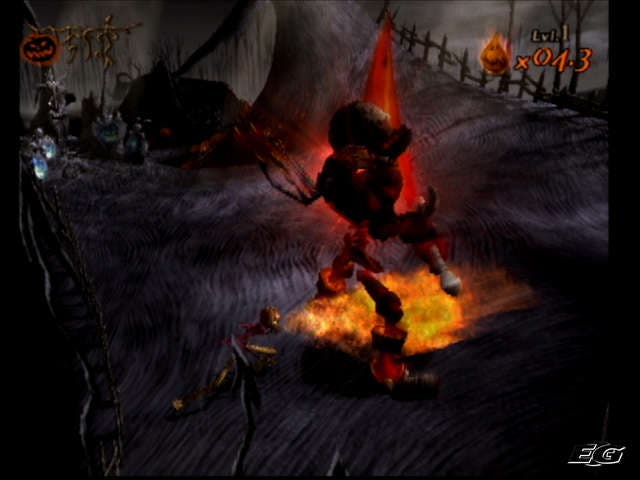Nightmare Before Christmas: Oogie's Revenge
Look how frightfully Gothic I am.
SOUL RUBBER! SOUL RUBBER! SOUL RUBBER! SOUL-
Look, can you stop please?
SOUL RUBBER! SOUL RUBBER! HALLOWEEN! HALLOWEEN!
Please shut up.
SOUL RUBBER! SOUL...
And so on. It's astoundingly irritating, is it not? Especially when you hear it once every second, shouted in gregarious actorial American drawl. But that's just one of the many surprises The Nightmare Before Christmas has to offer you. Every time you use the soul rubber - the primary fight mechanism - that imbecilic ejaculation will screech its way into your brain and make you wish to go on a killing rampage, were it not for the fact that you are Soul Rubbering your way around a world full of the already dead.
It's not clear why anybody bothers with cinematic tie-ins; studios, distributors, gamers alike. It is, after all, consummately well-received wisdom that to within an order of magnitude, every film-derived game has been a steaming, species-shaming nematode of awfulness, the kind of game that makes you want to scratch your eyes out with the controller. Atari started the hallowed tradition with ET, Acclaim perfected the fine art of making unbelievably wretched film licenses, and adherents of the bad-movie-tie-in-game practice their dark arts to this day.

Naturally, one of the reasons why such tie-ins tend to be so unspeakably abhorrent is because the rights to use the name in a heavily-neutered and badly-scripted approximation to the story takes up most of the budget, leaving little money to pay the artists, programmers, testers et al.; thus the game gets left to the tea ladies and their 14-year-old nephews.
The obvious way around this problem would be to adapt a film nearly 15 years old. You'd get the rights to that pretty cheaply, yet if that film has a sequel approaching, you can still hope to capitalise on the publicity you hope that will generate.
Well, that's what Capcom has done, and it's a pretty smart move. The Nightmare Before Christmas might have been made thirteen years ago, but has a number of unique selling points: it had a unique aesthetic; it was stop-motion animation that hasn't aged; it possesses a quasi-dark-and-brooding air that self-absorbed teenagers and goths love; there is a haunting Danny Elfman soundtrack. These factors all seek to make a film that is highly memorable, and doesn't seem that long ago. And, since they got the rights relatively cheaply, Capcom would be able to afford to do something really spectacular with it, right?
Well, theoretically, yes. Of course, this being the games industry Circa 2005, what it actually has done is take Devil May Cry, make it look a bit more Tim Burton, and then sell it off as a new game.
Well, we're not fooled.

It certainly doesn't offer anything above what Devil May Cry did. In some respects it offers quite a bit less. And, given that in the cool light of revisionism, Devil May Cry isn't nearly as great as everyone thought it was at the time, it doesn't add up to an especially compelling purchase.
Fixed cameras may have been acceptable in the time of Devil May Cry, but in 2005? Tsk. The dramaticam is in full effect here, using its advanced psychic knowledge to position itself to maximize both the beauty of the unfolding scene, and your irritation at being unable to see where you want to go.
The baddies, the way they look, move and the way you dispatch them all feel alarmingly familiar to anyone who has played through any of a number of other Capcom games. In fairness, you do have a rather unusual and briefly fun weapon, the aforeshouted SOUL RUBBER, which is a kind of luminous, semi-sentient bungee that grabs the generic-Gothic-baddy, which you can smash around a few times in a rather satisfying death-combo.

Initially, it seems rather unusual and different. But it's not. You quickly realise that these are basically all the moves you'll ever get in the game bar the fairly useless Pumpkin King Jack and Santa Claus Jack modes. These other modes are fun but worthless, except for one boss that's carefully constrained to require the use of all three fighting styles. The fighting gets dull quickly.
In accordance with other Capcom titles, the puzzling elements hover in an intellectual space between easy and brain-dead, which is a real wasted opportunity for this environment, which could have played host to some great and memorable puzzles. Not this-bit-of-Capcom's forte, I guess.
Neither, clearly, is platforming. The one thing you need if you want to have platforming is accurate control. What you get in Jack Skellington is frustrating, loose, twitchy control that raises an ire alarmingly quickly. When you press the jump button, Jack jumps forward. When Jack stops running, he takes an additional step forward. As a result of these two foolish control gotchas, you will fall to a hateful and unnecessary death. Frequently. To compound the insult, the game will then put you back right at the start of the chapter, and ignore your last save-point. Gah.

There is, perhaps, only one thing this game really does well, and it is the thing that you would hope they got right, lest the game would be entirely pointless, which is to say the appearance of Tim Burton's beautiful world of Nightmare Before Christmas.
The game offers a wonderful and entirely accurate recreation of the non-Euclidean Gothic paradise of Halloween Town and environs. It's breathtaking, and wonderfully true to the equally Tim Burton original. A great deal of pleasure can be taken wandering around and just staring at things, interrupted only by occasional bouts of the slapping of soul rubber on
skellington.
Taking everything into consideration, it doesn't strike me that Capcom was the right developer to be doing this franchise any sort of gaming justice. A team that specialises in interactive fiction could work wonders in a world such as this. Capcom, in trying to shoehorn one of their hack-and-slashers into this world, have produced something which is beautiful, but incoherent and ultimately rather average.







